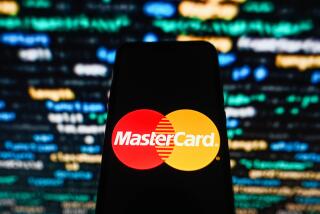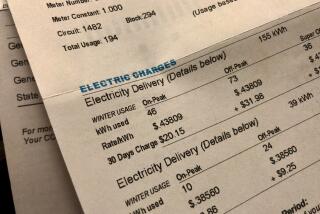Phone bills are moving back up
After enjoying years of falling prices, customers are starting to see monthly bills for phone service and high-speed Internet access rise again.
The nation’s dominant telephone and cellphone companies have competed on price for much of this decade, packing calling features into low-end offerings.
Now, with industry consolidations, faster networks and technologies that let phones, TVs and computers work together, the carriers are focusing on mid-priced packages -- the $40, $50 and $60 bundles that most customers buy.
The lure? Sell more services like call waiting, voicemail and text messaging add-ons -- priced as low as a few dollars a month each.
Think car dealers boosting profits by selling a sport package with a sunroof and alloy wheels.
Telecom giants AT&T; Inc., Verizon Communications Inc., Sprint Nextel Corp. and T-Mobile USA are adjusting plans and prices in efforts to increase their customers’ average monthly payments. Cable TV providers, a growing competitor to the phone companies, have long used this “value” strategy.
Competition and cost-saving technologies have steadily driven down phone and Internet prices, much to the chagrin of telecom investors. Even pay-TV customers enjoyed a small price drop last year -- in the few regions where phone companies offered TV service in competition with the cable industry.
Subscribers aren’t complaining. Discounted rates have become the most important factor in all buying decisions, according to a recent study by Forrester Research Inc.
“Consumers increasingly think price is more important than brand, and they are less likely to pay more for products that save them time and hassles or for products that they feel are consistent with an image that they like,” the report by Forrester analyst Bruce D. Temkin says.
But really cheap phone deals may be going the way of the rotary dial. The low introductory prices that do remain probably won’t last as long as they did a year ago. Analysts say the floor has been hit, and prices are heading up.
The typical bundle of local phone, long distance and DSL service, for instance, cost about 3% more in the last three months of 2006 than it did in the same period a year earlier, Banc of America Securities reported last week.
It was the first year-over-year increase the investment bank’s researchers had seen in phone and Internet pricing since they began tracking it in 2003.
Entry-level prices for stand-alone digital subscriber line service, known as DSL -- the phone companies’ high-speed Internet service -- rose as much as 34%. And both AT&T; and Verizon have bumped up pay-TV prices, even though they have made few inroads in that market.
“It’s too early to draw a conclusion, but it appears that competition is not leading us to a race to the bottom,” said Banc of America analyst David W. Barden.
Instead, he said, a duopoly is emerging where cable and phone companies can avoid provoking price cuts in their core services. Carriers, for instance, can discount DSL service while keeping prices up on phone service, and cable firms can drop prices for phone service but maintain higher pay-TV rates.
That’s good news for the carriers and their investors, who have wondered whether competition would drive dirt-cheap phone prices down further. Calls already are pennies a minute, and many Internet services are free.
But it’s bad news for customers, who are increasingly price conscious.
The Forrester study, which surveyed consumer buying attitudes over three years, found that half of respondents said the price of goods was most important to them, up from 46% in 2003. And the percentage of people who said they would pay more for products that saved time and hassles dropped to 34%, from 43%.
Gerald Murine, 75, balked at paying $5 extra for Verizon’s new high-speed fiber-optic Internet service at his home in Palm Desert. He had bought a package of phone and Internet service last March, but decided in November to cancel the phone service because he and his wife weren’t using it. They rely on cellphones.
“I called Verizon’s billing office to ask if by terminating my telephone service, it would impact my Internet service,” he said. “I was assured it would not.”
But Verizon also cut off the Internet service, which was priced at $39.95 a month. Murine said he couldn’t get the service reinstalled at the same price. He said he felt pressured to pay $44.95, but he signed a new one-year contract anyway.
“I need the Internet,” the retired aerospace software engineer said. “I pay my bills and do a lot of banking and stock stuff online.”
AT&T; and Verizon are following cable’s lead in adding more features to mid-level and high-end products as they try to generate more revenue per month from each customer -- a measurement that analysts and investors watch closely. And bundles of services are proving popular.
“The majority of our customers have some sort of bundled solution,” said Frank Mona, AT&T;’s Pacific region executive director for consumer marketing. “All the providers have gone to a fully featured bundle.”
AT&T; also is going to “everyday” pricing -- the normal rates customers pay -- rather than enticing new customers with artificially low introductory prices that Mona said generated too much turnover.
“Overall, average revenue per user has been flat,” said analyst Julie Ask of JupiterKagan Inc., a research and consulting firm. “So how do we grow revenue per customer? Part of the strategy is to make a la carte expensive so that customers buy packages.”
AT&T;, for instance, has one regulated rate for basic phone service in California -- $10.69 a month through 2008. But for 13 calling features, it recently raised rates as much as 57%, with prices now ranging from $2.99 a month for anonymous call rejection to $7.99 for caller ID.
However, for $24 a month, a customer can get basic local calling and all 13 features. While that may seem like a bargain, the incremental cost for AT&T; to provide all the features is close to zero. They already are built into the call-switching equipment that handles every customer’s line.
Wireless carriers also are increasing prices on such stand-alone features as text messaging, effectively pushing customers into buying a bucket of data for a monthly fee.
Low-end calling plans, which generally cost less than $30 a month, have been stripped bare of extra features, but carriers are piling features into their $40 to $60 offerings -- for “people who don’t want the cheapest plan but don’t want to pay a lot more either,” said Barden, the Banc of America analyst.
Customers who refused to pay an extra $15 a month last year for, say, unlimited text messaging are now willing to pay $5 more for a package of 400 or 500 short messages, opening the door to a variety of lower-priced add-ons.
Cingular Wireless, which is changing its name to AT&T; Wireless, and Sprint recently boosted the price of individual text messages for those without a monthly texting plan to 15 cents from 10 cents. Verizon on Friday said it would do the same starting March 1. Those extra pennies add up quickly, making a $5-a-month package of messages look cheap.
“Wireless companies are looking to lock people into three $5-a-month items, which lock people into giving companies a lot more recurring revenue,” said Ask, the JupiterKagan analyst.
Sprint also has abandoned last year’s highly touted overage plan that gave customers an hour of extra talk time for $5, rather than 40 to 45 cents a minute after the plan’s allotted monthly minutes were used up.
Instead, the company is offering “power packs” that give customer more “anytime” minutes and the ability to make unlimited calls after 6 p.m. for $5 a month. Its standard unlimited night-and-weekend package starts at 7 p.m., two hours before those offered by other major carriers.
“What we’re looking to do with our new direction is drive home the clarity of our position [and] make it more compelling,” said Scott Weiner, Sprint marketing vice president.
In mid-January, AT&T; launched its Unity calling plan that takes the bundle a step further -- it promotes the concept of a community of 100 million land-line and wireless customers who now can talk to each other for free. But to join the community, customers must buy an all-distance land-line plan and a Unity wireless plan that forces them to give up rollover minutes. Moreover, getting out of the one- or two-year contracts incurs an early termination fee of $175.
“If you spend less than $15 for long-distance calls each month, or if your cellphone bill is below the national average of $50, then you will waste your money on this plan,” said Bill Hardekopf, chief executive of consumer long-distance telephone comparison site SaveOnPhone.com.
The focus on higher stand-alone prices and value packages is helping to hold off the industry’s biggest fear -- a price war.
“We believe price is the most important variable to watch in the wireless industry,” Barden said. In a bid for growth, he said, “newly created titanic wireless entities” could start trying to pick off each others’ customers by lowering prices.
Only two major companies bucked the recent upward pricing trend, Barden’s report said. Sprint slashed introductory prices and added minutes to lower-priced plans, but it allowed its handset prices to rise an average of 20%. The other price cutter is Qwest Communications International Inc., the nation’s No. 3 land-line carrier, which serves 14 Western states but not California.
Cable companies, which pushed phone service heavily last year, kept bundled prices generally flat. Comcast Corp. and several others offered a bare-bones package of voice, video and data plans for $99 a month.
But few people paid that price because they were dissatisfied with the limited offering, Barden said. Most paid more to boost their Internet speeds or to add TV channels or phone features.
More to Read
Inside the business of entertainment
The Wide Shot brings you news, analysis and insights on everything from streaming wars to production — and what it all means for the future.
You may occasionally receive promotional content from the Los Angeles Times.










